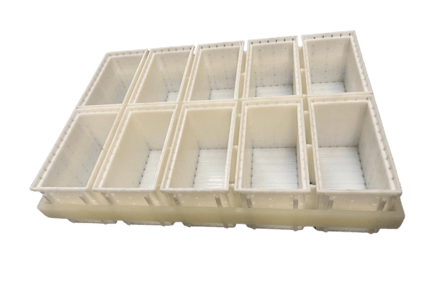Moulding soft cheeses efficiently
The first step to achieve a consistent production in soft cheeses is the moulding process.



.png?width=432&height=282&name=Untitled%20design%20(2).png)
Block-moulds in all shapes and sizes
Block-moulds are made from an assembly of moulds to maximize the number of cheeses and ensure optimal space between them.
Our experts will guide you in selecting the moulds and validation testing.
Moulding with Block-moulds
What you need to know about moulding with block-moulds.
Moulding organization
Moulding can be done from coagulation vats or the production vat onto a moulding table. A moulding station can also be used.
Distribution
The distributor is custom made of stainless steel or plastic for the mould and allows each mould to be filled uniformly. The exact curd volume corresponding to the mould block is poured onto the distributor for filling.
Stacking
Moulds or trays are stacked, allowing the whey to drain on the table. At this point, extenders are removed if necessary.
Flipping
The block-moulds are flipped several times during draining. This step is done by stacks in a flipping station or on draining tables, one tray at a time using an additional tray.
Demoulding
Demoulding is usually done by flipping the mould directly on an aging rack. Like this, the cheeses are spaced optimally for ripening.
Types de moules
There are two types of block-moulds that impact the daily work method. Choosing the moulds based on your plant and production method is important.

Block-moulds with bottom
Used without trays, draining and flipping in stacks

Bottomless Block-moulds
Used with trays and draining mats, they can be manually flipped.
.png?width=432&height=282&name=Untitled%20design%20(4).png)
Clipsed moulds
Without minimum of order, easy to clean, perfect for small dairies.
Mould selection
Here's how we work with you to choose the right mould.
Case study
We take the time to thoroughly understand the cheeses requirements, your working methods, and your future plans in order to propose the right mould.
Trials
From theory to practice, it's essential to conduct trials to validate the moulds produce the expected results and modify them if needed.
Design & offer
We present you with a design and an offer tailored to your production method.
Your everyday challenges
When you share your goals and challenges with us, we respond by analyzing your needs and proposing high-performance, tailored solutions.